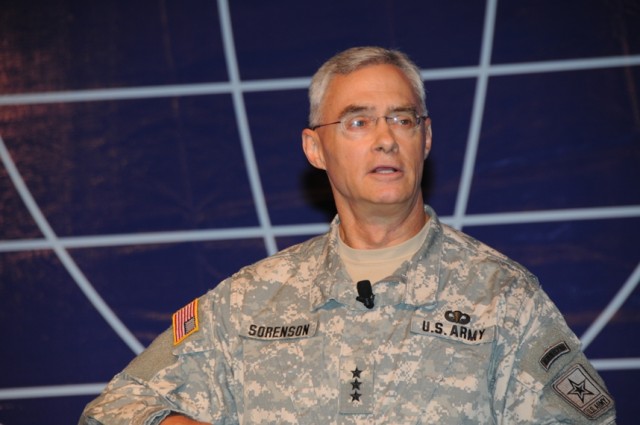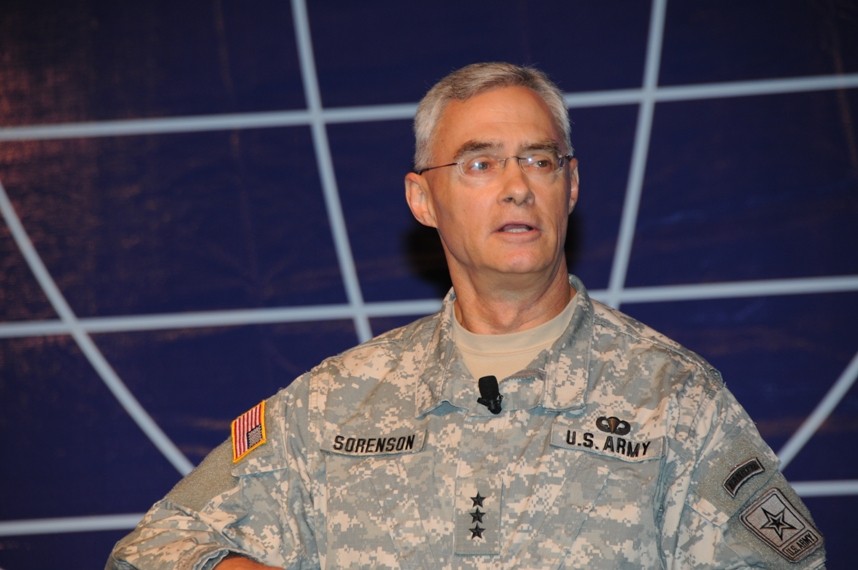FORT LAUDERDALE, Fla. -- Through the Global Network Enterprise Construct (GNEC), the objective is to restore balance on the Army's network in parallel with the Chief of Staff of the Army's goal to restore balance throughout the Army, according to Lt. Gen. Jeffrey A. Sorenson.
During his speech at the LandWarNet 2009 Conference, Sorenson, the Army's Chief Information Officer (CIO)/G-6, said that the need for joint interoperability has been one of the main topics on the minds of the Warfighters he has visited at numerous locations throughout the world.
GNEC is an Army-wide strategy that will transform LandWarNet from many loosely-affiliated independent networks to a single global integrated enterprise.
In previous interviews, Sorenson has likened the GNEC experience to that of a Blackberry, on which users can communicate by telephone or e-mail from anywhere in the world without replacing a phone number or Subscriber Identity Module (SIM) card. SIM cards can be switched among multiple phones, so that users can retain their personal identity information, cell phone number, phone book, text messages and other data.
"The analogy I would give you is: It's like your own personal home, where you have one provider giving you a phone; you have another provider for television or cable and you have another provider of Internet," he said. "Many companies today, such as Verizon, are packing all of those together and it essentially gives you that same capability for a reduced cost."
Everything over Internet Protocol (EoIP) has made this possible for these providers by converging data, voice and communications capabilities over the Internet, he said.
"I will say that we are kind of leveraging that into the future with respect to what we're going to do with the GNEC," Sorenson said.
The CIO/G6 has discovered that the formation of numerous networks over the years has hindered interoperability, said Sorenson during his speech.
Realizing that these networks lack certain essential facets like standardization and optimal levels of security, CIO/G6 created four operating principles.
The first is to collect or aggregate all data that relates to information technology assets, infrastructure, operations and governance.
The second is to consolidate what takes place on the network by making the best use of collected data and systems through federation. This involves making use of agreed standards, while still allowing organizations to manage their own systems and networks.
The third operating principle is to standardize the network. The goal is to achieve a common technical and operational picture to ensure seamlessness in the delivery of like capabilities and services across the enterprise network.
The final principle is to modernize systems and operations. These principles will not necessarily be executed sequentially, but they will occur in parallel, according to CIO/G6.
The end state will be a single enterprise network that is global, standardized and secure, Sorenson told the audience.
During the Network Service Center Operational Validation (NSC OPVAL), held from April through May, the 18th Fires Brigade successfully simulated a scenario of leaving its server equipment behind while notionally traveling from its headquarters of Fort Bragg, N.C., to its area of responsibility at Grafenwoehr, Germany.
During the OPVAL, the 18th Fires Brigade was trained to trust the fact that it wouldn't have to carry its equipment as it travelled from its headquarters to its area of responsibility, Sorenson said. During this scenario, the network would be present to support them.
In the future, GNEC will consolidate a proliferated collection of active e-mail directories for applications into one, he said. On behalf of the Defense Information Systems Agency (DISA), CIO/G6 is leading an initiative to bring about an e-mail strategy for the entire DoD. Currently, a member of the Army can not access an individual from a separate military branch through the Global Address List, the directory used to locate contact information.
The focus is to set this in place for the headquarters of Army Materiel Command (AMC), the Armed Forces Command (FORSCOM) and United States Army Transportation Command (TRANSCOM). Once this proves effective, DISA will take the lead in providing this to the entire force.
During his remarks to open the conference, Gen. Carter F. Ham, Commanding General of the U.S. Army, Europe and Seventh Army, called GNEC "the right thing to do" and "very, very exciting," while indicating that challenges lie ahead.
One challenge was that an Italian Commander could not access the laws, policies and procedures shared by the Army during Austere Challenge 2009, with which the NSC OPVAL coincided. This challenge needs to be resolved, he said.
Whether they are in their home station or in a mission, a Commander or unit needs to see the same network, he said.
As the Army looks ahead to Austere Challenge 2010, "We have a lot of challenges ahead of us and we will continue to push the envelope," Sorenson said.


Social Sharing